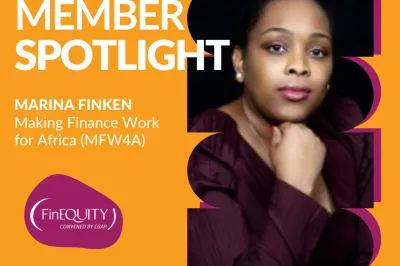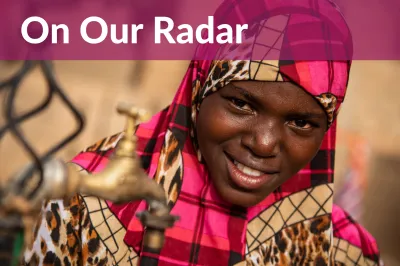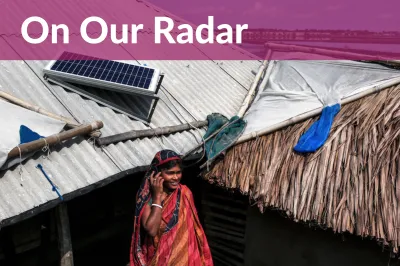What’s The Point of Increasing Women’s Financial Inclusion?

Women’s economic empowerment (WEE) requires transformative change in market systems to address power relations that result in the marginalization of women and girls. WEE is at the heart of achieving gender equality and women’s access to and use of meaningful financial services is one of the most powerful routes to get there. However, we must be more intentional, explicit and nuanced about the financial inclusion and WEE outcomes we expect and get a lot more serious and consistent about tracking, measuring and reporting on these outcomes.
More and more, those interested in advancing financial inclusion are asking the question – “finance for what?” – and in particular, this seems to be top of mind for those interested in women’s financial inclusion. Usually, the answer includes something about financial inclusion being a means to an end; about a shift toward the ‘real economy’ and how financial services can contribute to inclusive economic growth: improving livelihoods and creating jobs, increasing access to basic services – including health, education, housing, etc., – and contributing to greater resilience leading to sustainable futures. But we need to be intentional to ensure real economy benefits are achieved and, specifically, that increased financial inclusion of women always contributes to WEE.
In this essay, we discuss why we need to be intentional about these outcomes and what we expect to achieve when it comes to women’s economic empowerment through financial inclusion – that is, where are we going, how do we get there, and how do we know when we’ve arrived?
Where are we going?: What does it take for a woman to be economically empowered
FinEquity’s excellent brief summarizing the WEE measurement tools relevant for financial inclusion suggests empowerment comes down to three dimensions: access to resources, agency and achievements – or, as we like to call it, the “The 3A model of empowerment” (as depicted in Figure 1).
Figure 1: The 3A model of empowerment

First, to be empowered, women require access to resources.
This includes access to goods, services, and assets, as well as more intangible resources such as access to information and networks, and human and social capital. In the context of financial inclusion, examples might include:
- Access to formal and informal financial services
- Access to sources of knowledge, skills, and information that help build an individual’s numeracy, literacy, and financial capabilities
- Access to assets, such as mobile phones or land, which can serve as collateral for loan products
- Access to markets and opportunities
- Access to social networks and social capital, for example through savings groups
To be empowered, women also need the agency to set and pursue their own goals and make their own choices.
This includes active participation in decision-making processes and the power women have vis-à-vis other decision-makers (such as husbands and partners), as well as the ability and confidence to set their own goals. One important factor when considering agency is that women with lower levels of agency often shoulder a disproportionate share of the unpaid care burden including housework, meal preparation, childcare, care of elderly relatives and so on, which in turn reduces their ability to set goals and pursue other options outside the home. Other important features of agency include:
- Mobility, both physically – such as being able to leave the home without the permission of a male family member – and economically – such as being free to enter occupations that may be seen as ‘male occupations’
- Voice, self-confidence and leadership
- Financial independence and autonomy, such as having control over one’s own savings or income
- Freedom from violence, shame or stigma that might otherwise restrict the real set of choices available
Achievements considers the extent to which women are able to achieve the goals they have set for themselves and, as a result, enjoy meaningful improvements in well-being and life outcomes.
In terms of economic empowerment, this could include goals such as starting a new business or growing an existing business, earning higher income or securing employment in a desired occupation. Achievements can also include the non-economic benefits that result from these economic gains, such as improved health and education outcomes, as well as subjective benefits such as feelings of well-being, life satisfaction, and self-esteem.
Underpinning the access, agency, and achievements of individual women are a broader set of norms and institutions.
These “rules of the game” are the institutional and social systems that govern activities and mediate relations between individuals and their social and economic environment; they influence how resources are distributed and used. This includes cultural, social, political, and economic institutions, both formal and informal, that influence which resources women can access and the levels of agency they can exercise. For example, there may be a gender norm that favors men over women in the inheritance of land. This may be further reinforced and reflected in the laws around inheritance and land ownership, and in the cultural practices of community leaders, judges, and so on. This in turn shapes women’s control over land and the ability to access collateralized loans, as well as her financial autonomy and decision-making power in the household.
Just as empowerment is multidimensional and context-specific, and what counts as ‘empowerment’ can vary across contexts, regions, and individuals, the strength and influence of norms and institutions can vary across time and space and can interact with individual circumstances and characteristics in various ways. For example, women with higher levels of education and better access to legal services may be better able to challenge discriminatory informal norms around inheritance. In general, women (and men) may seek to circumvent or directly challenge institutions that create barriers to the achievement of their goals, thereby contributing to societal change. However, depending on the context, this can carry the risk of backlash or social sanctions for the individuals involved, which can be particularly harmful for women.
To achieve economic empowerment, we need to address these root causes of marginalization and disempowerment of women. Transformation of power occurs through the redistribution of resources toward women and by shifting the institutional structures that shape women’s choice and voice, allowing them to exercise agency and to achieve their economic goals and improved quality of life. This potentially requires changes in the economic, political, and social relations in the household, community, market, and the state.
How do we get there?: Empowerment pathways through financial inclusion
So how are interventions to increase women’s financial inclusion expected to contribute to improved WEE outcomes? From a project design perspective, this requires a systematic process to set out the specific WEE results we aim to achieve – such as those described earlier– as well as the causal mechanisms involved. It also requires a systematic recording of the theories or hypotheses underpinning these causal mechanisms and the assumptions or conditions necessary for them to hold, and finally, the testing of these assumptions and theories against the available data and evidence.
In developing empowerment pathways, it is important to acknowledge there is not necessarily a linear pathway from access to agency to achievements.
Each of the three A’s can interact in different ways and there can be both positive and negative feedback loops between the three different concepts. For example, to access a financial service such as an e-wallet, a woman will first need a minimal level of agency such as the ability to decide to open an account, the ability to negotiate successfully with her husband (if she first needs her husband’s permission), the mobility to leave the home and meet with the agent, and so on. She will also need access to other resources such as a mobile phone, information about the product, and the requisite levels of literacy and financial capabilities, which in turn may require additional starting levels of agency.
If the woman is able to access the financial service, this may further boost her agency (because she now has a safe, private space to save - thereby increasing her financial autonomy - and by allowing her to better spend her income in accordance with her own preferences), which in turn increases her achievements (because she can better achieve her economic goals, such as starting or growing a business). This may contribute to further gains in her agency if, for example, it further improves her self-confidence and negotiating power within the household (see Figure 2 below).
Figure 2: Hypothetical example of an empowerment pathway for digital financial services

Documenting the assumptions underpinning the empowerment pathway helps identify potential barriers to women’s economic participation and empowerment. For example, in a context where many women have low access to basic education, some may not have the requisite financial capabilities to access an e-wallet. From a project design perspective, this can help funders and facilitators think of ways in which the intervention can be modified in order to minimize these barriers, for example by working with a financial service provider to ensure the product interface is as simple as possible (or offers an interactive voice response platform to address barriers related to literacy or visual impairments) and that agents or bank tellers are trained to provide the necessary customer support. From a design and monitoring perspective, this process helps identify key assumptions to be tested and potential unintended negative outcomes that should be monitored for. It can also help to identify people and questions to investigate, such as monitoring husbands’ attitudes towards their wives accessing financial services like e-wallets.
Note there is also the potential for negative feedback loops or trade-offs. For example, access to a financial service that allows a woman to expand her business may increase her income (achievements) but also result in increased working hours which, without redistribution of unpaid care burdens (agency), will lead to increased time poverty and potentially lower life satisfaction overall. Similarly, gaining employment in a job that is informal, insecure, and with poor health and safety may not feel empowering and result in worse life outcomes on some metrics.
Participatory, self-defined empowerment outcomes
When mapping out the potential WEE outcomes for a given project or intervention, several WEE guidance notes recommend using participatory approaches whereby the women targeted by an intervention are themselves able to define what would count as a positive empowerment outcome. This recognizes the fact that what counts as ‘empowerment’ can vary across cultures, regions and individuals, and avoids the imposition of an outsider’s view of what women should want. It also helps to understand how women themselves would trade off different outcomes, such as extended working hours that increase income but may reduce leisure time and increase time poverty.
For example, the Arab Women’s Enterprise Fund (AWEF) developed a tailored qualitative research process using ‘vignettes’ that allowed for the collection of specific agency characteristics and pathways directly from female participants. The vignettes introduced an imaginary woman who represented a ‘typical case’ with whom participants could easily identify. The facilitator told the story of the woman as she progressed through accessing and using a financial service but stopped short of providing any outcomes. Participants were then asked to suggest the agency-oriented outcomes she might achieve. Once a sufficient number of agency characteristics were identified, participants voted individually on which agency outcomes were most important and likely to occur, resulting in a number of indicators to quantitatively measure agency.
How do we know when we’ve arrived?: Measuring WEE
What gets measured gets done, as they say – meaning that measuring something gives you the information you need in order to make sure you actually achieve what you set out to do. Measuring WEE outcomes allows funders and facilitators to track progress and test the causal theories and assumptions underpinning each link in the empowerment pathway, ultimately leading to an understanding of whether women are more empowered or not. Should WEE outcomes not materialise as expected, by measuring the length of the empowerment pathway we can pinpoint where the pathway is breaking down and therefore how the intervention design needs to change. By measuring agency as well as achievements it is also possible to assess whether any positive achievements observed actually reflect women’s own priorities and choices (the true measure of empowerment).
However, while the recent proliferation of women’s economic empowerment measurement guides, indexes and indicators demonstrates the increased interest in promoting WEE, this also makes it difficult to know which are most useful and practical to use in financial inclusion.
Indicators should focus on the specific aspects of access, agency and achievements identified in the empowerment pathway.
As noted above, WEE is complex and it is not possible to measure every aspect of empowerment for every intervention. Indicators should therefore focus on the specific aspects of access, agency and achievement that the intervention is expected to bring about (as identified in the empowerment pathways). This also means that while an intervention might use some common or standard WEE indicators (to aid comparability and aggregation across interventions), these should be complemented by project-specific indicators tailored to the particular empowerment pathway and relevant to the context.
A combination of quantitative and qualitative indicators, and indicators capable of capturing both the ‘depth’ and ‘breadth’ of change, are required.
In general, it is good practice to combine quantitative (numerical) and qualitative (descriptive) indicators. This is especially so in the case of WEE given the complexity and nuance involved in measuring empowerment outcomes and the subjectivity of many of the underlying concepts (such as self-confidence, wellbeing and self-esteem). Qualitative indicators can also provide a rich source of data regarding the barriers facing women in accessing financial services and in achieving their goals, data which can be used by funders and facilitators to adapt and improve intervention design and delivery.
Indicators can be defined to measure either the ‘breadth’ or the ‘depth’ of change. In the case of WEE, we typically want to measure change in both dimensions. For example, if a digital financial service project is expected to contribute to an increase in women’s financial autonomy, an indicator of breadth might be: ‘the number of women reporting an increase in savings that they control.’ An indicator of depth might be: ‘the average value of savings that women control’, or ‘qualitative changes in the extent to which women feel financially autonomous.’ Combining breadth and depth indicators allows project staff to assess both how many women have been reached, and how substantive or consequential the outcome changes are for the women concerned.
Given the real potential for unintended WEE outcomes – such as increased time poverty – and the trade-offs many women must negotiate – such as taking a job that provides increased income but that increases the risk of sexual harassment – the set of indicators defined needs to capture these different potential outcomes (to the extent that project monitoring and evaluation resources allow). For example, an indicator relating to the number of women gaining formal employment might be complemented by a qualitative indicator relating to job quality. Qualitative indicators are also useful for capturing unintended negative outcomes.
While it is important to attempt to capture the subjective elements of WEE, these types of indicators can be difficult to measure and subject to reporting bias and should therefore be complemented with more ‘objective’ indicators. Features of the data collection process itself – such as the gender of the enumerator or the time and place of the interview or survey – can also introduce measurement bias if not considered carefully. This is particularly the case with indicators relating to gender norms which can be subject to social desirability bias whereby respondents provide answers they think the enumerator wants to hear or that are more in-line with what is perceived to be socially acceptable behaviour (rather than the answers that best reflect their reality). Some people may also be uncomfortable speaking freely about certain WEE-related topics. It is therefore good practice, where possible, to combine subjective indicators with objective or proxy indicators.
Conclusion
The current focus on reducing the gender gap between women and men’s access to financial services is no longer sufficient. If we are serious about achieving gender equality, the end game should be about identifying and measuring the benefits for women from using financial services. We need to understand: What are women using financial services for? Are their lives improving as a result? Are women becoming more empowered? Is poverty being alleviated? Figuring out the answers to these questions requires us to not only define impact, but to measure it and to develop an evidence base of what really works in different contexts.
Ultimately, if we want to do more than simply build a slightly better financial system and focus on achieving development objectives, then we need to understand how increasing women’s financial inclusion contributes to women’s economic empowerment and be clear about why it’s worth investing in. hat is, we need to be clear on “What’s the point of increasing women’s financial inclusion?”


